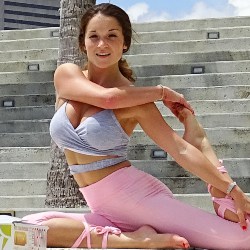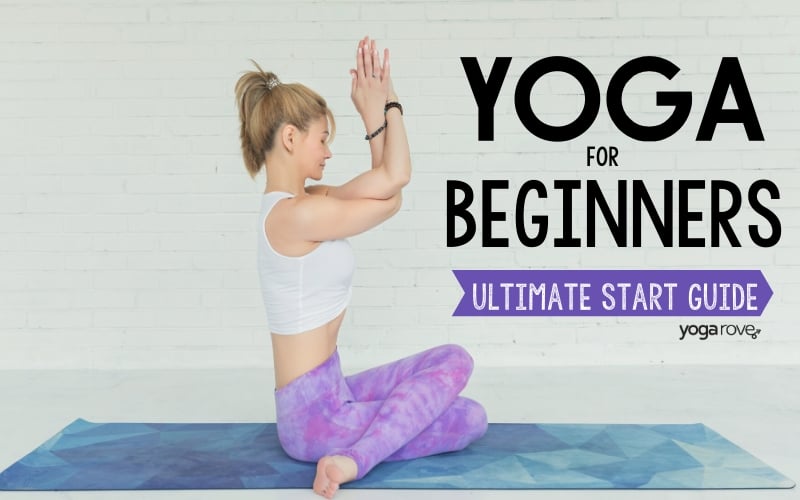This post may contain affiliate links. Please read our disclosure for more info.
There are hundreds of types of yoga in this world – and dozens that you see regularly on studio and gym schedules, but gentle yoga is one of the kinds that really doesn’t get the credit it deserves. I’ve been teaching yoga for 6 years, and practicing yoga for 16, and I can honestly say that my and my students’ deepest sense of calm (in body and mind) has been achieved through gentle and restorative yoga.
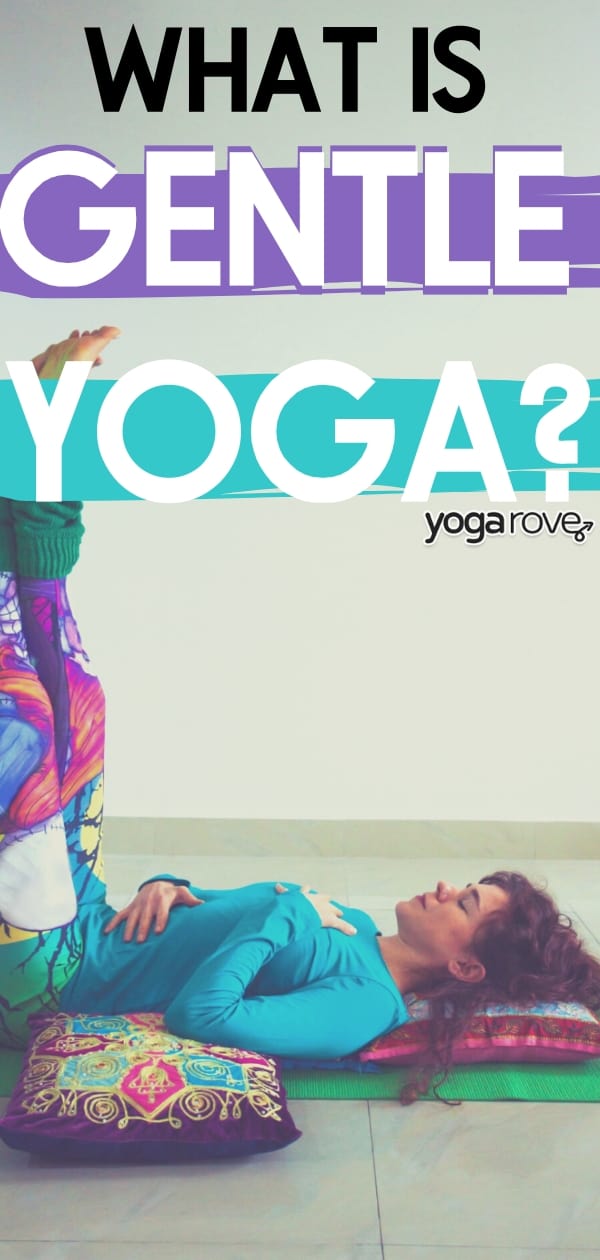
What Is Gentle Yoga? Gentle yoga, or restorative yoga, is an asana practice that eases the body into postures that are not taxing. By relaxing into postures that put the body at ease, the mind is put at ease and a sense of calm is restored to the body. Do not expect to exert considerable effort in a gentle yoga class!
Gentle yoga caters to all demographics and is big on being “inclusive rather than exclusive;” it is perfect for anyone recovering from an injury (with guidance), the elderly, anyone new to yoga, athletes who are tight and sore, rest day movement, and much more. Many people compare the feeling after a gentle yoga class to the same feeling after a wonderful massage.
Related Article: Restorative Yoga Sequence to Relax the Mind and Body
Benefits of Gentle Yoga
Why should you practice gentle yoga? There are many benefits both physical and mental:
1. Mind-Body Awareness
Through accessible range of motion postures in a slow-paced environment, you’re able to really tune into the physical feedback loop that each muscle and joint movement sends to your mind.
Gentle yoga offers you the space and time to feel every movement that you’re doing, since there is minimal movement and minimal effort. By practicing under these conditions, you start to really “listen” to your body, and as a result, your mind-body awareness increases.
You may also find that as you enter a more intimate space of awareness with yourself, you will learn to appreciate yourself more. So often we get frustrated with what our body can’t do, but how often do we take the time to appreciate what it can do? Increasing your awareness allows you to increase your appreciation.
2. Stress Reduction: stop the flight or fight response.
It seems as though our body is always in constant fight-or-flight response, without us even realizing it.
When you’re rushing to a meeting and don’t even have time to eat so you just chomp down on a granola bar, your body is thinking, “WOAH, we are in flight mode and we have no time to stop and eat so I need to preserve whatever is being consumed because I don’t know when I’m going to eat next!”
This ends up throwing your cortisol out of whack, which actually causes you to store more fat, which is why stress is a common cause of weight gain.
When you’re up for a deadline on a project and you can’t sleep at night, it’s because thoughts are speeding through your neural network. As a result, your body doesn’t get the sleep it needs, which stresses your body out even MORE.
This ends up making you act foggy, make more mistakes, and slows your reaction time, because your body is operating on “reserve-mode” instead of “sharp mode.”
Gentle yoga stops the fight or flight cycle in its tracks by creating a space of restoration, where your physical and physiological body can rebalance and think to itself “ok, I’m now in a space where I don’t have to operate on reserves anymore,” and your mind can recalibrate to “ok, I’m in a space of rest – my energy will be restored, so I can function at maximum capacity.”
3. Reduce Muscle Tension Through the Use of Supported Postures.
In order to fully relax, “we need to feel supported, both physically and mentally” (Eileen Goodard, Yoga Vida). By using support for the physical body, the “OK, I’m safe here” thoughts are triggered in the mind, and the body relaxes into its safe space.
When you feel supported, you are more at ease. Think about when a parent held your hand on your first day of school entering the classroom –you were able to relax a bit, knowing you had support. Your body’s just like that – give it support, and tension will release.
4.Better Recovery from Injury and General Soreness
Whether you’re an athlete constantly trying to push further, or someone who just experienced an injury, combining the practice of focusing on your range of motion and the use of support allows muscles to release easier, and therefore recovery time will speed up.
Are There Different Types of Gentle Yoga?
Technically, yes – gentle yoga is a genre that encompasses principles from Iyengar Yoga (very heavily prop based), Yin Yoga (which holds poses for 60 seconds or more), and Restorative Yoga (basically a blend of Yin & Iyengar). It often goes by the name “accessible yoga” as well, as it’s meant to be accessible to all ages and skill levels.
There are also a few specialty types of yoga that can also fall under the classification of gentle yoga. You usually won’t find these classes on standard schedules, and you may need to seek them out (sometimes in the form of personal sessions), but they are wonderful for the symptoms they aim to treat:
- Chair Yoga: This type of yoga is often offered in senior centers and in physical rehabilitation sessions after injury, as it’s super easy on the knees and wrists, since there’s no floor movement. It may not be as relaxing as gentle yoga, but it’s really great on mind-body awareness and for practicing yoga with joint problems
- Iyengar Yoga: Iyengar strongly focuses on alignment, and poses are held longer, just like in restorative yoga. Although it may not feel as gentle as a Gentle Yoga class, it is perfect for beginners looking to improve their practice and their mind-body connection. Props are also strongly encouraged and used in this type of yoga.
- Prenatal Yoga: Ask any mom who has taken prenatal classes through pregnancy and they will tell you that it only helped their pregnant experience!
- Mommy & Me Yoga: Similar to prenatal yoga, but it’s for after the baby is born. The mother & infant take a gentle yoga class together, and it allows them to bond. Don’t be concerned about your child crying – it’s totally normal and acceptable! These classes are also wonderful opportunities to meet fellow moms going through the same new-mommy experience.
How Often Should I Practice Gentle Yoga?
The answer to this depends entirely on your level of physical activity and your body’s capabilities.
Most yogis will tell you to practice at least 5 days per week, but the fact is that a “regular practice” is defined as 2 (or more) 45-75 minute classes per week will “produce the same significant meditative and calming benefits as practicing more than that”, according to a study. Plus, if you’re stressing yourself out about getting to enough classes, you’re totally defeating the purpose of gentle yoga– which is to destress!
If you are just starting yoga or are overcoming injury start out with 2 classes per week and work your way up to 3 classes. If you are feeling really great in your gentle yoga, perhaps take just 2 gentle yoga classes and then add 1 or 2 beginner or regular level yoga classes, which will allow you to build your strength and flexibility.
If you are using gentle yoga as an addition to your regular workouts or routine, 1 class a week in addition to regular physical activity is usually enough to calm the nerves and “detach” from the regular, movement-heavy physical activity you are used to practicing.
I highly recommend taking this class at the end of what’s considered your work week (if you work Monday through Friday, then a Friday evening class is a real treat).
Gentle Yoga Poses
If you can’t make it to a class or there are simply none, no worries! There are a few simple postures you can practice to obtain the full benefits on your own at home. These poses can be practiced each on their own, or in the order provided for a restorative flow:
Child’s Pose
- Start on all fours with hands under shoulders and knees a little wider than hip distance apart.
- On your exhale, gently push your hips back to rest on your heels. You can stay here or widen your knees further for a Wide Child’s Pose.
- Walk your fingertips forward to provide a gentle stretch. Rest your forehead on the ground, close your eyes, and focus on your breath.
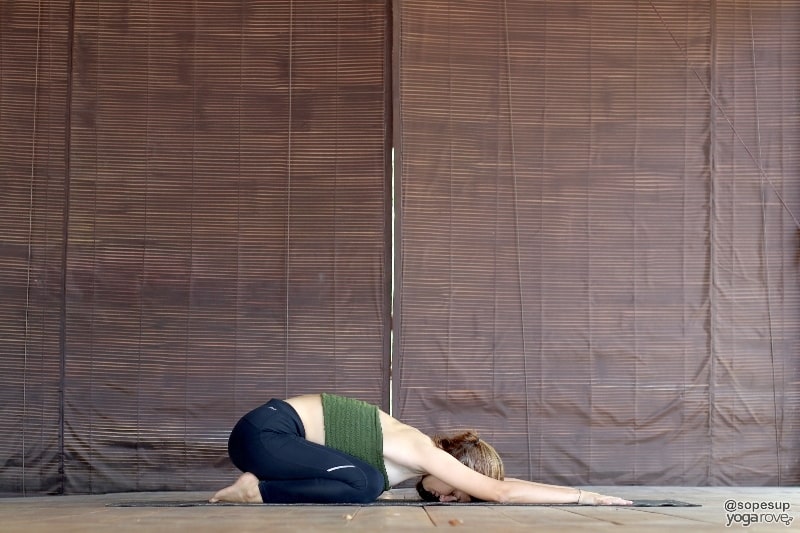
Rag Doll
- Start in Mountain Pose, standing tall and feet strongly grounded.
- Place your hands on your hips and begin to slowly hinge at your waist until you are folded over in Standing Forward Fold.
- Instead of keeping your legs straight, slightly bend them and allow your top body to relax.
- Allow your head and arms to hang loosely, shaking your head slowly for a stretch and maybe grabbing opposite elbows.
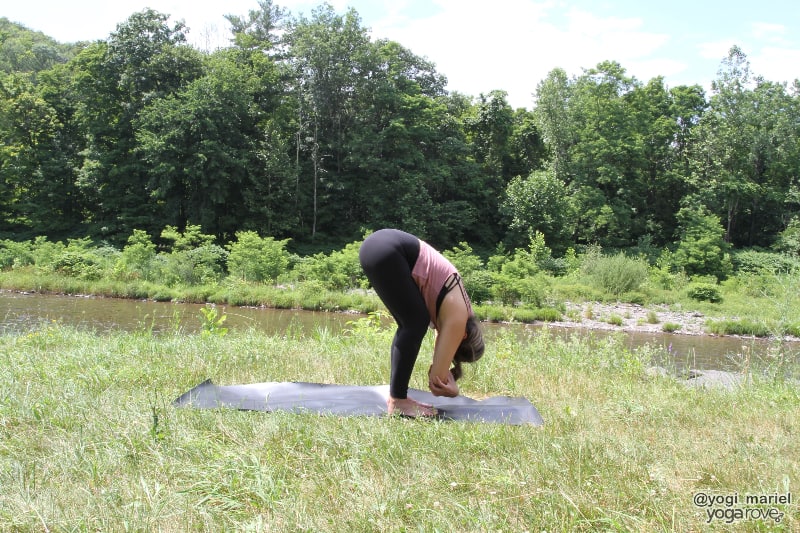
Standing Wide-Legged Forward Fold
- Start in Mountain Pose, then step your feet as wide as you can while still being able to keep them grounded.
- Rotate your toes slightly in and heels slightly out.
- Place your hands on your hips and begin to slowly hinge at your waist, keeping a flat back.
- Allow your head or hands to come to the ground and relax your body into the pose.
- Walk your hands between your legs to provide a gentle stretch.
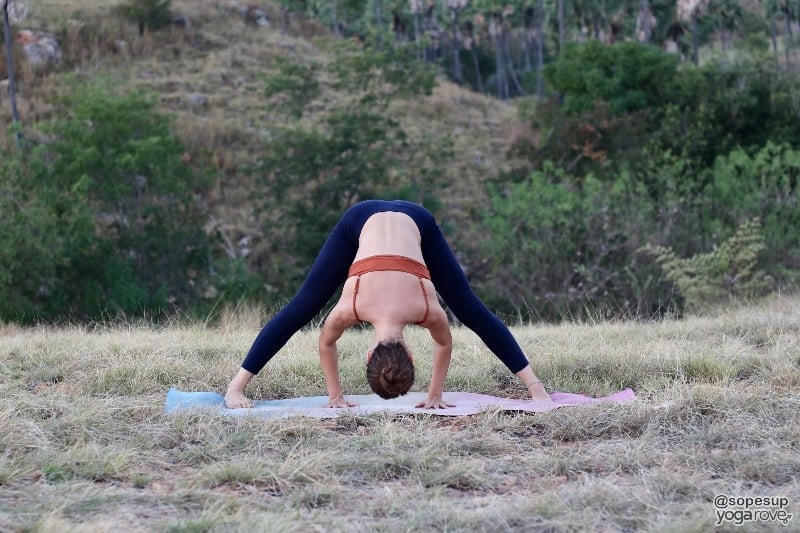
Reclined Bound Angle
- To start off, set up a blanket behind you that will support your back and neck comfortably.
- Start in a seated position with a straight back. You can place a towel or blanket underneath you for comfort.
- Bend your knees and place the bottom of your feet together.
- Stay here for a second to become aware of your body and any tight areas.
- Begin to slowly lean backwards until you are supported by the blanket.
- Rest your hands by your sides or on your stomach and close your eyes.
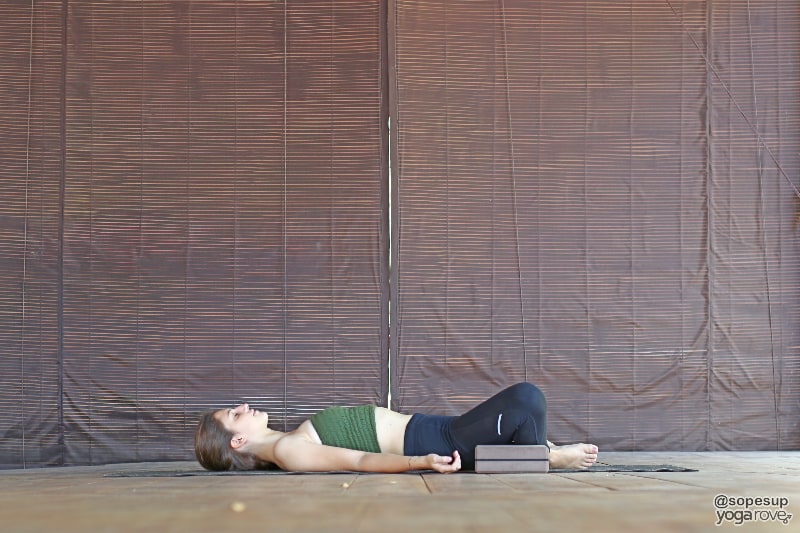
Reclined Pigeon
- Start on your back with knees bent and feet flat on the ground.
- Bring your right ankle to rest on your left thigh, flexing your right foot.
- Bring your feet off the ground into your chest.
- Place your hands behind your left thigh (right by the crease of your knee) and gently pull it towards you, gently deepening the stretch.
- Keep your head in a neutral position and shoulders on the ground.
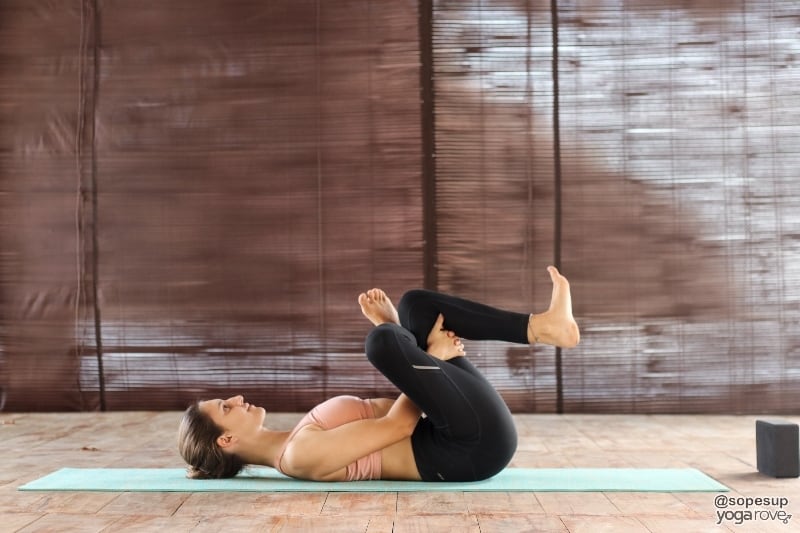
Happy Baby
- Start on your back with your knees bent and feet flat on the ground, then bring them into your chest.
- With knees in the air, bring your legs wider than your hips with feet flexing back towards you.
- Grab your toes or sides of your feet with your hands and gently pull your legs towards the ground.
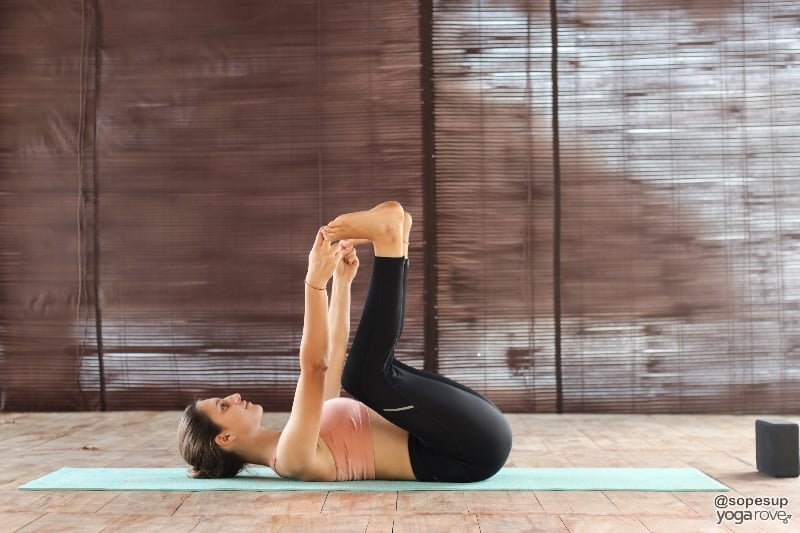
Supported Bridge
- This pose is best used with a yoga block, so to start, make sure you have one by you.
- Start on your back with knees bent, feet flat on the ground, and inner hip distance apart.
- Slightly lift up enough to place a block underneath your sacrum. Adjust the height to what feels comfortable to you.
- Allow yourself to fully rest on the block to form a milf beck bend.
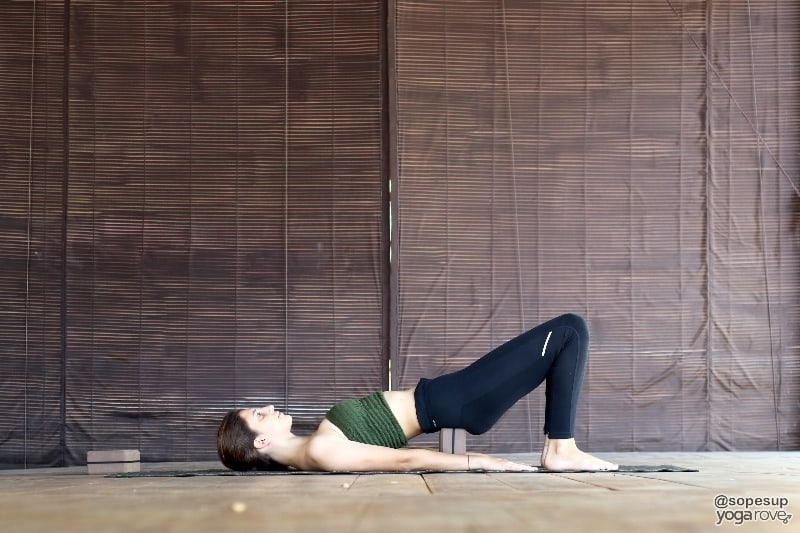
Corpse Pose
- Start lying on the ground, allowing your limbs to fall into loose, comfortable positions.
- Shut your eyes and begin to notice your breath.
- Do a body scan by focusing on one part of your body at a time, releasing any tension that might still be present.
- Focus on your breath and allow body and mind to completely let go and relax.
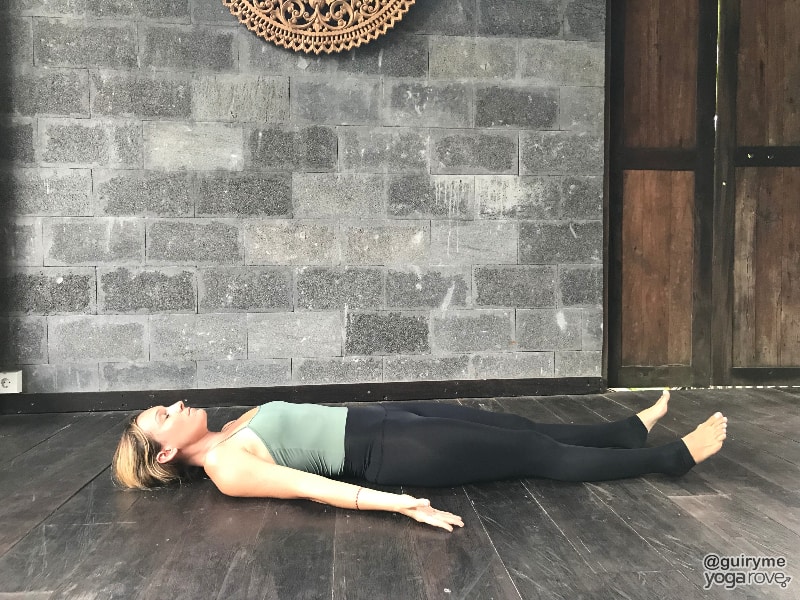
If you want more yoga routines, you can also check out our Free Resource Library for simple yoga workout cards that include both sweaty and restorative routines.
Modifications for Gentle Yoga Poses
- Knees rise higher than your hips while seated? Sit on a block.
- Can’t sit up straight without your back slouching or knees bending? Sit on a block, blanket, or pillow.
- Lower back tension in reclined corpse? Place a bolster under the knees.
- Hips uncomfortable in reclined bound angle? Place blocks underneath the outside of the knees on either side of you to support the posture.
- Knees don’t touch the floor beside you in reclined twist? Place a block or bolster underneath the top knee.
- Head or neck come off the floor when reaching for feet in happy baby? Use straps or towels looped around the feet to hold onto with the hands, so that the head and neck can release flat along the mat.
DIY Yoga Prop Substitutions
Restorative yoga will make the best use of the most props available – yoga blocks, bolsters, cushions, blankets, straps – you name it!
If you are practicing at home you don’t necessarily need to go out and purchase fancy yoga blankets or expensive meditation cushions.
Quite frankly, the only item you can’t “DIY” at home is a yoga block, and those are relatively low-priced online or at a local homeware or sporting goods store. These are the ones from Amazon we recommend.
Here are some simple and FREE substitutions you can use in place of yoga props to still have a fulfilling Gentle Yoga practice at home:
- Instead of a yoga bolster, use a small chair or couch cushion, or a firm pillow.
- Instead of a yoga strap, use a towel or even a large T-shirt. Repurpose any towel, shirt, or other clothing item that’s on its way to the garbage by simply cutting a long strip of it!
- Instead of a yoga blanket, use a thick towel or thick throw blanket – you want a texture that will not flatten in thickness easily (so those super soft fuzzy throw blankets are not the best for this purpose)
Is Gentle Yoga Difficult?
Physically, absolutely not, but mentally, it may be nearly impossible (read E.J. Johnson’s first experience of a gentle yoga class – funny, but not unrealistic).
If you are someone that knows the benefits of meditation but just can’t get yourself to sit still, you’re the someone that is going to think a gentle yoga class is mentally difficult. However, you’ll probably think it’s just slightly easier than attempting to meditate, so it’s a great alternative to meditation.
Is Gentle Yoga Boring?
Honestly, if you are not familiar with meditative or slow practices, and you are a more fast-paced person (whether in your general workouts or your day-to-day life outside of the gym), you will probably sit in your first yoga class thinking “how much longer is left;” “I could just be sitting on the couch relaxing;” “am I doing this right?” – and you’re probably the person that needs this class the most!
You know all those social media and phone detoxes that people do nowadays? Think of gentle yoga as a detox from fast-paced, overthinking.
Don’t force yourself into something you hate, but do recognize that these anxious thoughts are totally normal, and they’re basically a fast-paced “detox” that you’ll experience your first one to few times. (If after your 3rd class or so you totally hate it, it’s probably not for you, and you can say you truly gave it a shot).
Our minds are running in 20 directions at once (sometimes 200 – really depends on the kind of day life throws at us, doesn’t it?), and we don’t often remind ourselves to hit RESET.
We’re basically just really complicated computers; think of your laptop if you don’t shut it down for more than a week – it gets sluggish in all its processes until it finally gets restarted or you shut it down for the night (instead of just closing the lid and letting it go to sleep – we are all guilty of it, I know).
A lot of us (myself included) turn to intense workouts, like calorie-torching spinning classes, limit-crushing HIIT workouts, heavy weights, long runs, and more, because these types of exercises blow off the steam we accumulate through life’s day-to-day stresses. Sometimes there is no better feeling than that heavy tiredness that you get after giving a workout your all.
But… let’s remember the RESET. These aggressive workouts are definitely a form of mental reset in their own right when it comes to stress, but they’re certainly not a physical reset. They’re also not exactly the best reset when it comes to calming the breath and physiological processes, which have direct impact on your thought quality, awareness, and general stress levels.
Give yourself the reset you deserve by treating yourself to a gentle yoga class!
Related Questions
Is Hatha Yoga considered gentle?
Although Hatha Yoga can be gentle, I wouldn’t consider it a genre of Gentle Yoga. Hatha Yoga is an umbrella term for many different types of yoga, but in the western world, the term is used to describe a more “beginner-friendly” class that focuses more on seperate poses rather than flows.
What should you wear to practice Gentle Yoga?
Anything that is comfortable and loose fitting. You don’t want something tight and restrictive as you want your body and mind to completely feel at ease. If you’re at home practicing, wearing your pj’s is definitely a popular option!
Is Restorative Yoga good for back pain?
Although the gentle postures in Gentle or Restorative Yoga can be very beneficial to combating pain by relaxing and releasing tension, this type of yoga alone shouldn’t be used to treat back pain. You need to also integrate strengthening sequences into your routine to improve core and spinal strength. But if you are presently in pain, always consult with a doctor before practicing any type of exercise.
Previously a dancer, Ashley has been practicing yoga for over 15 years and teaching for 5.
She balances an executive-level “corporate” position during the day with healthy, mindful wellness practices in her free time to stay grounded; she lives on celery juice and cold brew, and can’t live without her dark chocolate!


